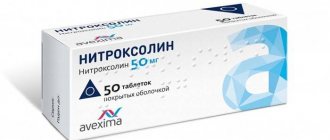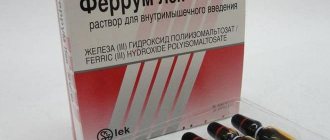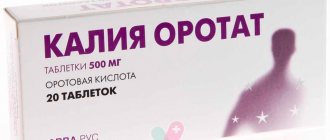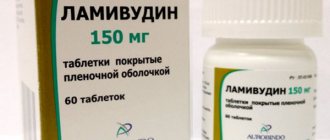Iodine balance - tablets with potassium iodide for the treatment and prevention of ailments that develop due to a lack of microelement in the body.
The drug is designed as a source of iodine to restore its normal level in the body. It is also prescribed to prevent pathologies caused by its deficiency: iodine deficiency conditions and diseases during pregnancy and lactation, after thyroid surgery, treatment of euthyroid goiter in young patients (starting from the newborn period).
Release form and composition
Dosage form - tablets: from yellowish-gray to almost white, round, with beveled edges, on the flat surface of one side there is an engraving “EM 33” and a dividing line on both sides or “EM 70” and a dividing line on the other side ( 25 pieces in blisters, 2 or 4 blisters in a cardboard pack).
The active substance of Iodine Balance is potassium iodide:
- 1 tablet engraved “EM 33” – 130.8 mcg, which is equivalent to 100 mcg of iodine;
- 1 tablet engraved “EM 70” – 261.6 mcg, which is equivalent to 200 mcg of iodine.
Auxiliary components: corn starch, magnesium stearate, colloidal silicon dioxide, microcrystalline cellulose, lactose monohydrate, cellulose powder.
Composition of the drug
The medicine is available in tablet form, which contains the main substance potassium iodide (100 and 200 mcg, if iodine is calculated).
The composition includes as excipients:
- Silica.
- Magnesium stearate.
- MCC.
- Corn starch.
- Cellulose powder.
- Lactose monohydrate.
After administration, the medicine penetrates well into the blood in the thin part of the digestive tract and reaches its destination. Metabolic products are excreted through the kidneys .
Pharmacological properties
Pharmacodynamics
Iodine, which is part of the drug Iodbalance, is one of the vital microelements. Without it, normal functioning of the thyroid gland is impossible, since iodine is present in the hormones triiodothyronine and thyroxine. Thyroid hormones are necessary for the development of all systems and organs; they take part in the regulation of protein, carbohydrate, fat and energy metabolism, as well as the activity of the nervous system, brain, cardiovascular system, mammary and gonads. Iodine is necessary for the normal growth and development of a child and the formation of his mental abilities. Iodine deficiency is especially dangerous in childhood and adolescence, as well as during pregnancy and lactation.
Iodine balance replenishes iodine deficiency in the human body, prevents the appearance of goiter caused by a lack of this trace element in food, and prevents the occurrence of iodine deficiency conditions and diseases. As a result of the use of Iodine Balance, the size of the thyroid gland in children, including newborns, adolescents and adult patients, is normalized.
Pharmacokinetics
After oral administration, the drug is almost completely absorbed in the small intestine. In healthy individuals, the average volume of distribution is about 23 liters (38% of body weight).
Normal plasma iodine concentration is 0.001–0.005 μg/ml. It accumulates in the salivary glands, stomach tissues, thyroid gland and mammary glands. The concentration of iodine in saliva, breast milk and gastric juice is approximately 30 times higher than the plasma concentration.
The drug is excreted in the urine. The iodine content in urine in relation to creatinine (µg/g) is an indicator of iodine intake in the body.
Indications for use
Iodine balance is recommended to be taken in the following cases:
- Prevention of iodine deficiency conditions and diseases (including endemic goiter), including in pregnant and breastfeeding women;
- Prevention of goiter recurrence after surgery to remove it, as well as after completing a course of treatment with thyroid hormones;
- Treatment of diffuse euthyroid goiter in children (including newborns), adolescents and young adults.
Contraindications
- Hyperthyroidism;
- Thyroid cancer (including if its presence is suspected);
- Subclinical hyperthyroidism (for an iodine dose of more than 150 mcg per day);
- Diffuse and focal functional autonomy of the thyroid gland and solitary toxic adenomas of the thyroid gland;
- Dühring's dermatitis herpetiformis;
- Nodular toxic goiter (except for blockade of the thyroid gland in preparation for surgery);
- Glucose-galactose malabsorption syndrome, galactose intolerance, lactase deficiency;
- Hypersensitivity to iodine.
For hypothyroidism, Iodine Balance should not be taken, except in cases where the development of the disease is caused by severe iodine deficiency.
Concomitant administration of the drug should be avoided during the therapeutic use of radioactive iodine.
Due to the risk of hyperkalemia, caution is recommended when taking iodine in renal failure.
Pharmacokinetics
Suction and distribution
When taken orally, the drug is absorbed almost completely in the small intestine.
Vdaverage for healthy people is 23 l (38% of weight). Normal plasma iodine concentration is from 0.001 to 0.005 mcg/ml. It tends to accumulate in the glands - thyroid, salivary, mammary and stomach tissues. Moreover, the concentration in saliva, gastric juice and breast milk compared to that in blood plasma is approximately 30 times higher.
Removal
It is eliminated from the body through urine. The concentration of iodine in urine is relative. creatinine (µg/g) turns out to be an indicator of its direct entry into the body.
Instructions for use of Iodine Balance: method and dosage
The tablets are taken orally, after meals, with a sufficient amount of liquid.
For infants and children under 3 years of age, the tablet should be dissolved in 1 tablespoon of boiled water at room temperature.
When prescribing the drug, it is necessary to take into account the characteristics of the region of residence and the amount of iodine supplied with food; this is especially important when determining the dose for children under 4 years of age.
The daily dose is taken once, recommended dosage:
- Prevention of iodine deficiency pathologies: newborns and children - 50-100 mcg, adolescents and adults - 100-200 mcg of iodine, during pregnancy and breastfeeding - 100-200 mcg;
- Prevention of relapse of thyroid enlargement after completion of hormonal therapy or surgical removal of goiter: 100-200 mcg of iodine daily.
When treating diffuse euthyroid goiter, adolescents and young adult patients are prescribed Iodine Balance 200 mcg, newborns and children - 100-200 mcg.
The doctor determines the duration of taking Iodine Balance individually, depending on the clinical indications. Typically, the duration of treatment for goiter in newborns is 0.5-1 month, in children, adolescents and adults - 6-12 months or more, preventive treatment - from several months or years, often throughout life.
on our website:
Iodine balance
Company Nycomed
re-registered the drug
Iodide
in Russia in dosages of 100 and 200 mcg under the new trade name
Iodbalance
.
The same process is at the final stage of re-registration in other CIS countries. The re-registration of the drug under a new trade name was caused by the need for legal protection of the trademark in the Russian Federation and CIS countries. Re-registration was not accompanied by any changes in the technology and composition of the drug. Thus, the drug Iodbalance
is a new brand of the previously well-known drug
Iodide 100
and
Iodide 200
.
During 2006 - 2007, the drug Iodide
will be completely replaced in the retail chain by the drug
Iodbalance
.
Iodine balance
was registered in Russia as a medicine in August 2005.
The active ingredient is potassium iodide, presented in two dosages of 100 and 200 mcg, 100 tablets per package, registration certificate P No. 012281/01. The registered price of Iodine balance
remained the same as for the drug
Iodide
.
Trade (proprietary) name of the drug
Iodine balance
Registration number:
P N012281/01 dated 07/29/2005
Generic name of the drug
Potassium iodide
Compound
1 tablet contains:
active substance:
potassium iodide - 130.8 or 261.6 mcg (corresponding to 100 or 200 mcg of iodine).
excipients:
lactose monohydrate, cellulose, corn starch, colloidal silicon dioxide, magnesium stearate, microcrystalline cellulose.
Description
Flat-cylindrical tablets from almost white to white with a yellowish tint. On one side of the tablet there is a line mark, on the other side there is an engraving: EM 33 (100 mcg tablets) or EM 70 (200 mcg tablets).
Pharmacotherapeutic group
Thyroxine synthesis regulator is an iodine preparation.
ATX code:
H03CA
Pharmacological properties
Iodine is one of the vital trace elements. Without iodine, normal functioning of the thyroid gland is impossible, since it is an integral part of thyroid hormones. Thyroid hormones are involved in the regulation of metabolic processes in the body: protein, fat, carbohydrate and energy; in the development of all organs and systems, regulate the activity of the brain, nervous and cardiovascular systems, reproductive and mammary glands, the growth and development of the child, the formation of his intellectual abilities. Iodine deficiency is especially dangerous for children, adolescents, pregnant and lactating women. Iodine balance, being a source of iodine, replenishes its deficiency in the body, prevents the development of iodine deficiency diseases, and prevents the development of goiter associated with a lack of iodine in food; normalizes the size of the thyroid gland in newborns, children, adolescents and adults.
Indications for use
- prevention of endemic goiter;
- prevention of goiter recurrence after its surgical removal, as well as upon completion of goiter treatment with thyroid hormone preparations;
- treatment of diffuse euthyroid goiter in newborns, children, adolescents and young adult patients.
Contraindications
- severe thyrotoxicosis;
- latent thyrotoxicosis (when using doses exceeding 150 mcg/day);
- Dühring's dermatitis herpetiformis;
- toxic adenoma, nodular goiter when used in doses of more than 300 mcg/day (with the exception of preoperative therapy to block the thyroid gland);
- hypersensitivity to iodine.
Iodine balance should not be taken for hypothyroidism, except in cases where the development of the latter is caused by severe iodine deficiency. Prescription of the drug should be avoided during therapy with radioactive iodine, the presence or suspicion of thyroid cancer. Use during pregnancy and breastfeeding.
During pregnancy and breastfeeding, the need for iodine increases, so it is especially important to use Iodine Balance in sufficient doses to ensure adequate iodine intake into the body (iodine intake should be at least 200 mcg per day).
The drug penetrates the placenta well and can cause the development of hypothyroidism and goiter in the fetus. Iodine is also excreted in breast milk. Therefore, the use of the drug during pregnancy and breastfeeding is possible only in recommended doses.
Directions for use and doses
Dosage
Prevention of the development of endemic goiter: Newborns and children:
50-100 mcg of iodine per day (1/2 - 1 tablet of Iodine Balance 100)
Adolescents and adults:
100-200 mcg of iodine per day (1 - 2 tablets of Iodine Balance 100 or 1/2 - 1 tablet of Iodine Balance 200)
During pregnancy and breastfeeding:
200 mcg of iodine per day (1 tablet of Iodine Balance 200 or 2 tablets of Iodine Balance 100)
Prevention of goiter relapse after its surgical removal or upon completion of treatment with thyroid hormones:
100 -200 mcg of iodine daily (1-2 tablets of Iodine balance 100 or 1/2 - 1 tablet of Iodine balance 200).
Treatment of euthyroid goiter: Newborns, children, adolescents, young adult patients:
100 -200 mcg of iodine per day (1 - 2 tablets of Iodine Balance 100 or 1/2 - 1 tablet of Iodine Balance 200). The daily dose of the drug should be taken in one dose, after meals, with a sufficient amount of liquid. The use of the drug for prophylactic purposes is carried out for, as a rule, several months or years, and often throughout life. For the treatment of goiter in newborns, in most cases, 2-4 weeks are sufficient; in children, adolescents and adults it usually takes 6-12 months or more. The duration of treatment is determined by the doctor.
Side effect
With the prophylactic use of Iodine Balance, as well as with therapeutic use in newborns, children and adolescents, as a rule, no side effects are observed. Sometimes allergic reactions occur: skin rash, Quincke's edema.
Overdose
With long-term administration of high doses of the drug (more than 300 mcg per day), the development of iodine-induced hyperthyroidism is possible (especially in elderly patients, in the presence of nodular goiter or toxic adenoma).
When treated with high doses of iodine (more than 1000 mcg per day), in some cases iodine-induced goiter and hypothyroidism may develop. Chronic overdose can lead to the phenomenon of “iodism”: metallic taste in the mouth, swelling and inflammation of the mucous membranes (rhinitis, conjunctivitis, gastroenteritis, bronchitis); acne; dermatitis; swelling of the salivary glands; temperature increase; irritability. Interaction with other drugs
The effectiveness of treatment with thyreostatics while taking iodine is reduced. Potassium perchlorate and thiocyanate inhibit iodine uptake by the thyroid gland. Taking high doses of iodine and simultaneous administration of potassium-sparing diuretics can lead to the development of hyperkalemia. The simultaneous administration of iodine therapy in high doses and drugs contributes to the development of goiter and hypothyroidism.
special instructions
It should be taken into account that during drug therapy in patients with renal failure, hyperkalemia may develop.
Release form
Tablets 100 and 200 mcg.
25 tablets per blister. 2 or 4 blisters with instructions for use are placed in a cardboard box. Storage conditions
: Protected from light, at a temperature of 15-30°C, out of the reach of children.
Best before date
3 years. Do not use after the expiration date indicated on the package.
Vacation conditions
Over the counter.
, Germany. Frankfurter Strasse 250, 64293 Darmstadt, Germany
Address of the representative office in Russia and the CIS:
119021 Moscow, st. Timur Frunze, 24. Tel.: 933-55-11, fax 937-98-37.
| To main |
Overdose
When using Iodine Balance in a daily dose of more than 150 mcg, patients with lesions with functional autonomy in the thyroid gland may develop iodine-induced hyperthyroidism. High daily doses of iodine (more than 1000 mcg) in some cases can lead to hypothyroidism and goiter formation.
With a chronic overdose of Iodine Balance, the phenomenon of “iodism” is possible, manifested by the following symptoms: a metallic taste in the mouth, swelling of the salivary glands, acne, inflammation and swelling of the mucous membranes (conjunctivitis, rhinitis, bronchitis, gastroenteritis), dermatitis, fever, irritability.
In case of chronic overdose, you must stop taking the drug. In case of iodine-induced hyperthyroidism, Iodine balance should be discontinued and treatment with antithyroid drugs should be started. In especially severe cases, intensive care measures are carried out, plasmapheresis or surgery to completely or partially remove the thyroid gland is prescribed.
If symptoms of hypothyroidism occur, treatment with the drug should be stopped and iodine-containing thyroid hormones should be prescribed.
Adverse events during treatment
Most patients respond positively to this product and note. The drug is well tolerated, but one cannot fail to mention some side effects that are still possible:
- Allergic reactions.
- In serious cases, Quincke's edema.
- If you exceed the dosage recommended by your doctor, you may develop hyperthyroidism.
- If you constantly violate the dosage, this is fraught with the development of the phenomenon of iodism; it is characterized by the following symptoms:
- Swelling of the mucous membranes.
- Runny nose.
- Inflammation of the bronchi.
- Metallic taste in the mouth.
- Rashes on the skin.
- Increased nervous excitability.
- Body temperature exceeds normal.
- The salivary glands swell.
It should be separately noted that alcohol does not combine with most medications and Iodine Balance is no exception. Drinking alcohol increases the risk of developing undesirable manifestations, and the effectiveness of the drug is reduced. Therefore, doctors recommend abstaining from drinking alcoholic beverages during the course of therapy.
special instructions
The use of iodine can be started only after the patient has excluded hyperthyroidism, toxic nodular goiter, or a history of these pathologies.
When prescribing Iodine Balance to patients with renal failure, it is necessary to take into account the possibility of developing hyperkalemia.
In patients with a predisposition to autoimmune thyroid diseases, the formation of antibodies to thyroid peroxidase is possible.
When radioactive iodine is used for diagnostic or therapeutic purposes, its accumulation may be prevented by saturation of the thyroid gland with iodine. Therefore, before using radioactive iodine, you should stop taking Iodine Balance.
Do not violate the dosage regimen, especially during pregnancy and breastfeeding.
When using the drug by a woman during breastfeeding, additional iodine is not required for the child.
Iodine balance does not affect the patient’s ability to drive vehicles and machinery.
Interaction
The effect of antithyroid drugs when taken together with iodine preparations is reduced. The absorption of iodine by the thyroid gland is reduced when taking potassium perchlorate . Taking high doses of iodine supplements with potassium-sparing diuretics leads to hyperkalemia . Iodine metabolism and uptake by the thyroid gland is stimulated by TSH . Simultaneous long-term use of high doses of iodine and lithium preparations leads to the development of goiter and hypothyroidism .
Use during pregnancy and lactation
Pregnant and lactating women have an increased need for iodine, therefore, during pregnancy and breastfeeding, Iodine Balance is used to ensure that the required amount of iodine enters the body. Iodine crosses the placenta and into breast milk. Breastfed babies receive iodine through breast milk, so if a woman takes Iodine Balance, additional iodine-containing medications are not required for the child.
It is necessary to strictly adhere to the recommended doses of the drug and take into account the amount of iodine that a pregnant or lactating woman enters the body with food.
Analogs
Microiodide
Tatkhimpharmpreparaty (RF)
Price: (100 tablets) – 110 rub.
Medicines with potassium iodide. It is used to eliminate microelement deficiency in the body and prevent pathologies in pregnant, lactating women, children, and adolescents.
Available in tablets containing 0.1 mg iodine. Contraindications and recommended dosages are identical to Iodine Balance.
Pros:
- Available remedy
- Convenient dosage.
Flaws:
- Possible side effects.
Reviews of Iodine Balance
Patients and specialists leave positive reviews about Iodine Balance. Women who took the drug during pregnancy and breastfeeding noted an improvement in the condition of their skin and hair. Iodine balance is necessary for the normal metabolism of mother and fetus and the prevention of retardation in the mental and physical development of the child. However, pharmacists warn that the indicated doses should not be exceeded.
Endocrinologists often prescribe the drug to patients with thyroid diseases, especially in winter. Iodine balance stimulates brain activity, adds vigor and energy, and improves overall well-being.
Among the advantages of the drug, patients also note the ease of use and large packaging, which lasts for a long time.









